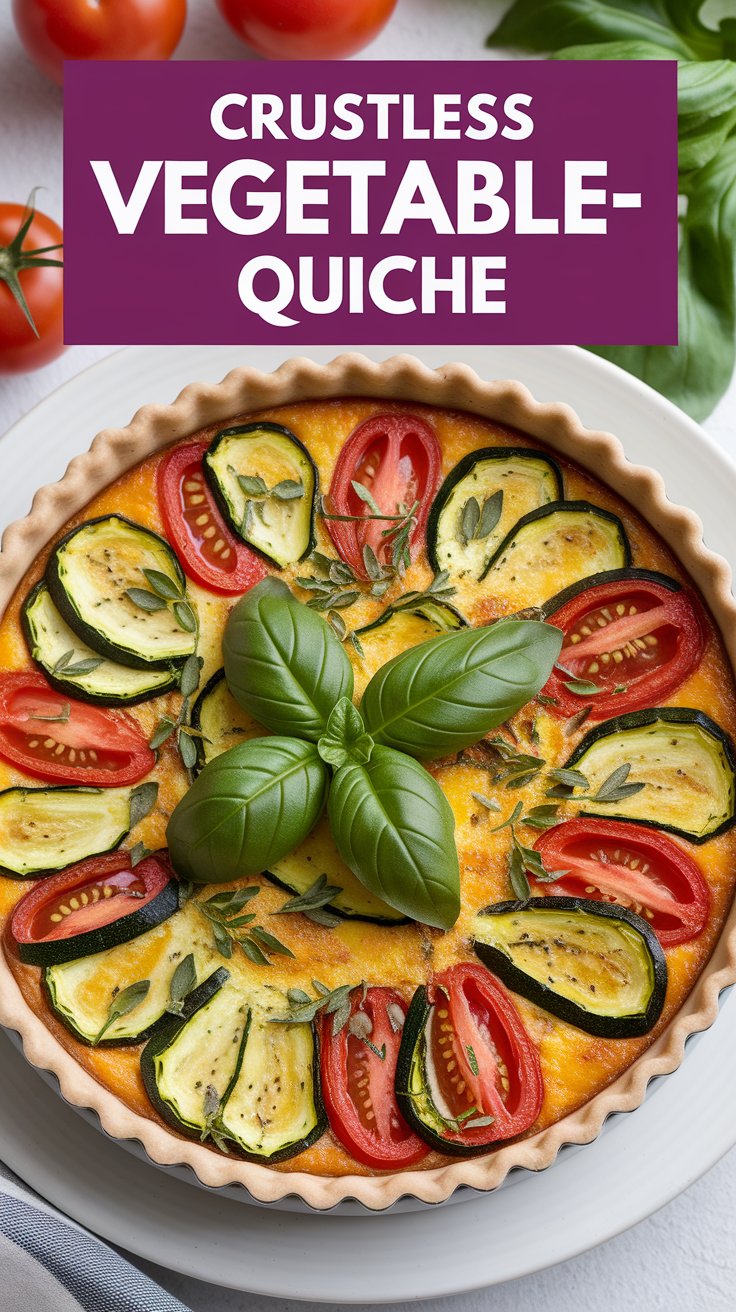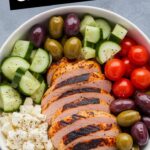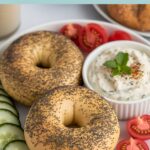There is something undeniably comforting about the aroma of eggs, cheese, and vegetables baking in the oven. For many people, weekends are a chance to slow down, share meals with loved ones, and indulge in food that feels both nourishing and special. One dish that has earned a permanent spot on brunch menus around the world is quiche. But while the traditional quiche with its buttery pastry crust is delightful, not everyone has the time, skill, or desire to fuss with dough on a busy morning.
That is where the crustless vegetable quiche comes to the rescue. By removing the pastry crust, you not only save preparation time but also make the dish lighter, healthier, and naturally gluten-free. This recipe highlights the beauty of fresh vegetables bound together with fluffy eggs and melted cheese. The result is a dish that looks elegant on the table, yet comes together with minimal effort.
Whether you are preparing breakfast for your family, hosting friends for brunch, or planning your weekly meal prep, a crustless vegetable quiche is a versatile solution. It works well hot out of the oven, at room temperature, or even reheated on a busy weekday morning. The balance of protein, vitamins, and flavor makes it a well-rounded option for both adults and children.
In this guide, we will dive deep into everything you need to know about making the perfect crustless quiche. From understanding the origins of this dish to exploring variations, nutritional value, and practical tips, you will walk away with a recipe that is both foolproof and endlessly customizable.
What Is a Crustless Vegetable Quiche?
Quiche is a French dish that traditionally consists of a savory custard made with eggs, cream, and cheese, baked inside a pastry crust. Perhaps the most famous variety is the quiche Lorraine, filled with bacon and cheese. Over the years, this dish has traveled the world, adapting to different cultures and tastes.
The crustless version takes the same savory egg custard but skips the crust entirely. Instead, the filling is poured directly into a greased dish and baked until golden. This approach was popularized by home cooks who wanted a quicker, healthier alternative without sacrificing flavor.
The absence of crust has several advantages:
- Lighter and lower in calories – Perfect for people watching their carb intake or those following a gluten-free lifestyle.
- Easier preparation – No rolling, blind-baking, or worrying about soggy bottoms.
- Vegetable-forward – The absence of pastry allows the colorful vegetables and creamy egg base to shine.
Essentially, a crustless quiche is the meeting point between a frittata and a traditional quiche. It holds together like a pie but retains the simplicity of a baked egg dish.
Why This Recipe Works
A good recipe is more than just a list of ingredients. It’s about balance—balancing textures, flavors, and nutritional values. This crustless vegetable quiche has all the qualities that make it a reliable choice:
- Health Benefits
- Eggs provide high-quality protein, essential vitamins, and minerals.
- Vegetables like spinach, zucchini, broccoli, and peppers deliver fiber, antioxidants, and vibrant color.
- The lack of pastry means fewer empty calories and less saturated fat.
- Budget-Friendly
- The dish uses pantry staples and common vegetables.
- Leftover vegetables from your fridge can easily be incorporated, minimizing waste.
- Customizable to Any Diet
- Low-carb and keto-friendly by nature.
- Gluten-free without needing specialty flours.
- Adaptable to dairy-free diets with plant-based milk and cheese.
- Meal-Prep Friendly
- Can be baked ahead and reheated throughout the week.
- Freezes well in individual slices for grab-and-go meals.
- Crowd-Pleasing
- Works for brunch buffets, potlucks, or family dinners.
- Appeals to both vegetarians and omnivores.
Ingredients Explained
Eggs – The Foundation
Eggs are the backbone of this recipe. They provide structure and create the custard-like texture that makes quiche so satisfying. Eight large eggs usually provide the right balance between fluffiness and firmness. For a lighter version, you can substitute some whole eggs with egg whites.
Milk or Cream – Creaminess and Richness
Milk softens the texture, while cream adds richness. Whole milk strikes a balance, but if you want extra indulgence, use half-and-half or heavy cream. For dairy-free alternatives, unsweetened almond or oat milk works well.
Vegetables – Color, Flavor, and Nutrition
This is where creativity shines. Common choices include:
- Spinach – adds a vibrant green color and pairs beautifully with cheese.
- Zucchini – light and delicate in flavor.
- Broccoli – offers crunch and earthy notes.
- Bell peppers – sweet and colorful, enhancing presentation.
Other options include mushrooms, leeks, asparagus, and cherry tomatoes. Just remember to sauté vegetables to remove excess moisture.
Cheese – Melted Goodness
Cheese binds the dish and adds indulgence. A combination of cheddar and mozzarella works beautifully. Parmesan provides a salty punch and helps create a golden crust on top. Goat cheese or feta can be used for a tangy variation.
Herbs and Spices – Elevating Flavor
A pinch of thyme, Italian seasoning, or herbes de Provence adds depth. Fresh herbs like parsley, chives, or basil can be sprinkled in before baking or as garnish. For a touch of heat, red pepper flakes or paprika work wonders.
Step-by-Step Instructions
- Prepare the Dish
- Preheat oven to 350°F (175°C).
- Grease a 9-inch pie dish with butter or non-stick spray.
- Cook the Vegetables
- Heat olive oil in a skillet over medium heat.
- Sauté onion until translucent, then add garlic.
- Stir in bell pepper, zucchini, and broccoli until tender.
- Finally, add spinach and cook until wilted.
- Whisk the Egg Mixture
- In a large bowl, whisk together eggs, milk, salt, pepper, and herbs until just combined. Avoid overbeating.
- Assemble the Quiche
- Spread the sautéed vegetables evenly in the pie dish.
- Sprinkle half of the cheese on top.
- Pour in the egg mixture.
- Finish with the remaining cheese and Parmesan.
- Bake to Perfection
- Bake for 35–40 minutes until the center is set but slightly jiggly.
- A knife inserted into the center should come out clean.
- Rest and Serve
- Allow to rest for 10 minutes before slicing.
- Garnish with fresh herbs and serve warm or at room temperature.
Pro Tips for Success
- Avoid Excess Moisture: Always sauté watery vegetables like zucchini or mushrooms to prevent a soggy quiche.
- Cheese Strategy: Layering cheese both under and on top of the egg mixture creates a rich texture and golden crust.
- Don’t Overbeat: Too much air in the eggs can cause the quiche to puff dramatically, then collapse.
- Test for Doneness: A slight jiggle in the center is perfect; it will firm up as it rests.
- Make-Ahead Friendly: Vegetables can be cooked the night before, making assembly quicker in the morning.
Variations to Try
- Mediterranean – Add olives, sun-dried tomatoes, and feta.
- Southwest – Use black beans, corn, jalapeños, and top with avocado.
- Autumn Harvest – Roasted butternut squash, sage, and caramelized onions.
- Spring Garden – Asparagus, leeks, peas, and goat cheese.
- Protein-Packed – Mix in cooked chicken, bacon, or turkey sausage.
- Dairy-Free – Use almond milk and dairy-free cheese or nutritional yeast.
Nutritional Breakdown
Approximate per serving (8 servings):
- Calories: 215
- Protein: 15g
- Carbohydrates: 6g
- Fat: 15g
- Fiber: 2g
This makes it suitable for low-carb, gluten-free, and keto-friendly diets.
Storage & Make-Ahead Options
- Refrigeration: Store in an airtight container for up to 4 days.
- Freezing: Wrap individual slices in plastic wrap and freeze for up to 3 months.
- Reheating: Warm in the oven at 325°F (165°C) for 10–15 minutes or microwave for 1–2 minutes.
Serving Suggestions
- Pair with a fresh arugula or mixed greens salad.
- Serve alongside roasted potatoes for a heartier meal.
- Add a fruit platter for natural sweetness.
- Offer crusty bread or toast for those who miss the pastry crust.
- For festive brunches, serve with mimosas or iced tea.
Common Mistakes & Fixes
- Watery Quiche: Caused by skipping vegetable sautéing. Always cook off moisture.
- Rubbery Texture: Result of overbaking. Remove once center is slightly jiggly.
- Bland Flavor: Underseasoned eggs or lack of herbs. Always taste vegetables before mixing.
FAQs
Can I prepare crustless vegetable quiche ahead of time?
Yes. You can assemble the unbaked quiche the night before, refrigerate, and bake the next day.
Can I make it dairy-free?
Absolutely. Replace milk with almond, soy, or coconut milk and use dairy-free cheese.
What vegetables work best?
Broccoli, zucchini, peppers, spinach, mushrooms, asparagus, and tomatoes are great options.
Can I freeze quiche?
Yes. Slice, wrap individually, and freeze for up to 3 months.
How do I know it’s cooked?
The edges will be set, the center will jiggle slightly, and a knife will come out clean.
Conclusion
A crustless vegetable quiche is more than just a recipe; it is a strategy for stress-free, wholesome cooking. It is versatile, customizable, and suitable for a wide range of diets. With its balance of protein, vegetables, and cheese, it can easily be served for breakfast, lunch, or dinner.
Next time you want to impress guests or simplify your weekly meal prep, try this dish. Experiment with seasonal vegetables, explore flavor variations, and make it your own.



